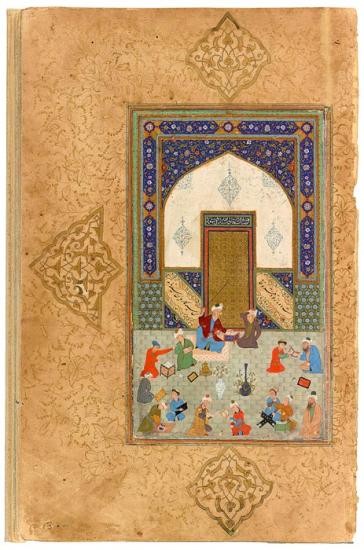
Classroom Scene
Shāh va darvish (The King and the Dervish), in Persian
Finished 19 January 1540, written by Mīr Calī al-Kātib al-Sulṭānī, probably for Cabd al-caziz Sulṭān.
Purchased by Pierpont Morgan before 1913
Hilālī, a Persian poet of Turkish origin, wrote three masnavīs (narrative poems in rhyming couplets), including a Lailā and Majnūn story with a happy ending and the present work, which was criticized in the memoirs of Bābur, the future Mughal emperor. Hilālī had made the dervish the lover and the king the beloved, making him a shameless strumpet.
School scenes were especially popular in Bukhara, reflecting the current emphasis on public education, and were derived from those depicted in the story of Lailā and Majnūn. The headmaster is about to strike a student, who catches his turban. Other students read, misbehave, write, or polish paper (left corner). ˓Abd al-˓Aziz Sulṭān (d.1549), for whom this manuscript is believed to have been commissioned, established a library that was supposedly without equal.
Persian poetry
The Persians loved their poetry and their poets, though the Qur˒an warned against believing their words (sura 69.41) and "those straying in evil who follow them" (sura 26.224). While Arabic was the first language of Islam and the language of the Qur˒an, Persian was favored by poets. Even Firdausī's (940–1020) celebrated Shāhnāma (Book of Kings), the national epic of Persian, was written in verse—some 50,000 couplets! Rūmī (1207–1273), the best known of the Sufi poets, put poetry in perspective when he wrote, "A hundred thousand books of poetry existed / Before the word of the illiterate [Prophet] they were put to shame!" (Masnavī I, 529). Presented here are illustrations of Firdausī's Shāhnāma as well as works by Sa˓ dī (ca.1184–1292), Hāfiz (ca. 1320–1389), and Jāmī (1414–1492), regarded as the last of the great Sufi poets. Also featured are illustrations from each of the five poems of the Khamsa (Quintet), by Niẓāmī (ca. 1141–1209), especially Lailā and Majnūn (The Persian Romeo and Juliet) and Bahrām Gūr's Seven Princesses.
